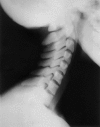Six novel missense mutations in the LDL receptor-related protein 5 (LRP5) gene in different conditions with an increased bone density
- PMID: 12579474
- PMCID: PMC1180253
- DOI: 10.1086/368277
Six novel missense mutations in the LDL receptor-related protein 5 (LRP5) gene in different conditions with an increased bone density
Abstract
Bone is a dynamic tissue that is subject to the balanced processes of bone formation and bone resorption. Imbalance can give rise to skeletal pathologies with increased bone density. In recent years, several genes underlying such sclerosing bone disorders have been identified. The LDL receptor-related protein 5 (LRP5) gene has been shown to be involved in both osteoporosis-pseudoglioma syndrome and the high-bone-mass phenotype and turned out to be an important regulator of peak bone mass in vertebrates. We performed mutation analysis of the LRP5 gene in 10 families or isolated patients with different conditions with an increased bone density, including endosteal hyperostosis, Van Buchem disease, autosomal dominant osteosclerosis, and osteopetrosis type I. Direct sequencing of the LRP5 gene revealed 19 sequence variants. Thirteen of these were confirmed as polymorphisms, but six novel missense mutations (D111Y, G171R, A214T, A214V, A242T, and T253I) are most likely disease causing. Like the previously reported mutation (G171V) that causes the high-bone-mass phenotype, all mutations are located in the aminoterminal part of the gene, before the first epidermal growth factor-like domain. These results indicate that, despite the different diagnoses that can be made, conditions with an increased bone density affecting mainly the cortices of the long bones and the skull are often caused by mutations in the LRP5 gene. Functional analysis of the effects of the various mutations will be of interest, to evaluate whether all the mutations give rise to the same pathogenic mechanism.
Figures








References
Electronic-Database Information
References
-
- Balemans W, Ebeling M, Patel N, Van Hul E, Olson P, Dioszegi M, Lacza C, Wuyts W, Van Den Ende J, Willems P, Peas-Alvers AF, Hill S, Bueno M, Ramos FJ, Tacconi P, Dikkers FG, Stratakis C, Lindpainter K, Vickery B, Foernzler D, Van Hul W (2001) Increased bone density in sclerosteosis is due to the deficiency of a novel secreted protein (SOST). Hum Mol Genet 10:537–543 - PubMed
-
- Balemans W, Patel N, Ebeling M, Van Hul E, Wuyts W, Lacza C, Dioszegi M, Dikkers FG, Hildering P, Willems PJ, Verheij JB, Lindpaintner K, Vickery B, Foernzler D, Van Hul W (2002) Identification of a 52 kb deletion downstream of the SOST gene in patients with van Buchem disease. J Med Genet 39:91–97 - PMC - PubMed
-
- Beals RK (1976) Endosteal hyperostosis. J Bone Joint Surg Am 58:1172–1173 - PubMed
-
- Beals RK, McLoughlin SW, Teed RL, McDonald C (2001) Dominant endosteal hyperostosis: skeletal characteristics and review of the literature. J Bone Joint Surg Am 83A:1643–1649 - PubMed
-
- Bollerslev J, Andersen PE Jr (1988) Radiological, biochemical and hereditary evidence of two types of autosomal dominant osteopetrosis. Bone 9:7–13 - PubMed
Publication types
MeSH terms
Substances
Associated data
- Actions
- Actions
- Actions
- Actions
- Actions
- Actions
- Actions
LinkOut - more resources
Full Text Sources
Other Literature Sources
Medical
Molecular Biology Databases

